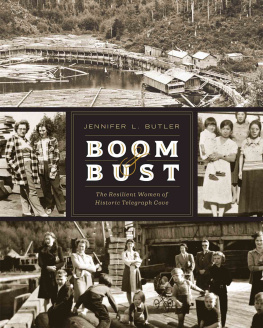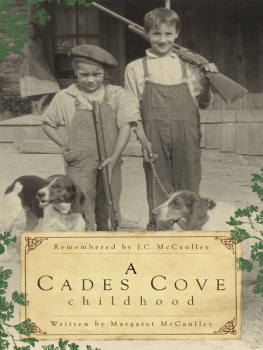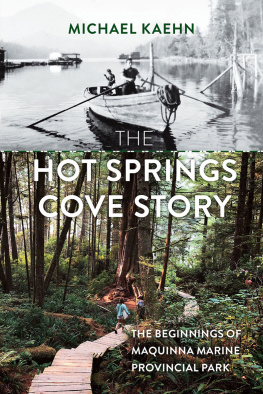Copyright 2019 by Jennifer L. Butler
All rights reserved. No part of this publication may be reproduced, stored in a retrieval system, or transmitted in any form or by any meanselectronic, mechanical, recording, or otherwisewithout the prior written consent of the publisher. For more information, please visit touchwoodeditions.com.
Editing by Claire Philipson
Design by Colin Parks
Maps by Dan OLeary
COVER PHOTOGRAPHS
Top: Telegraph Cove in the 1920s. Courtesy of the Wastell family.
Middle left: Stella Kulchysky (left) and Thelma Burton, circa 1950. Courtesy of the Burton family.
Middle right: Nancy Okura, circa 1940. Courtesy of the Okura family.
Bottom: War wives and other residents on Boat Day, 1943. Courtesy of the Wastell family.
Back: Women of Telegraph Cove, early 1930s. Courtesy of the Wastell family.
A NOTE ABOUT THE TYPE
The body of Boom & Bust was set in Capital Serif and Capital Gothic, the superfamily designed by Emil Bertell, Erik Bertell, and Teo Tuominen, and published by Fenotype in 2018. Titles are set in styles of Dallas Print Shop, designed by Emil Bertell and Teo Tuominen, and published by Fenotype in 2018; and Trade Gothic LT, based on designs by Jackson Burke in 1948, and published by Linotype in 2000.
LIBRARY AND ARCHIVES CANADA CATALOGUING IN PUBLICATION
Title: Boom & bust : the resilient women of historic Telegraph Cove / Jennifer L. Butler.
Other titles: Boom and bust
Names: Butler, Jennifer L., 1958- author.
Description: Includes index.
Identifiers: Canadiana (print) 20190053747 | Canadiana (ebook) 2019007163X | ISBN 9781771512985 (softcover) | ISBN 9781771512992 (PDF)
Subjects: LCSH: Telegraph Cove (B.C.)HistoryAnecdotes. | LCSH: Telegraph Cove (B.C.)BiographyAnecdotes. | LCSH: Telegraph Cove (B.C.)Social life and customsAnecdotes. | LCGFT: Anecdotes.
Classification: LCC FC3849.T45 B88 2019 | DC 971.1/2dc23
We acknowledge the financial support of the Government of Canada through the Canada Book Fund and the Canada Council for the Arts, and of the Province of British Columbia through the British Columbia Arts Council and the Book Publishing Tax Credit.

The information in this book is true and complete to the best of the authors knowledge. All recommendations are made without guarantee on the part of the author. The author disclaims any liability in connection with the use of this information.
23 22 21 20 19 1 2 3 4 5
I dedicate this book to my mother, my grandmother, and to all women, heard and unheard, who have shown resilience in challenging times.

Telegraph Cove in the mid-1920s. Courtesy of the Wastell family.
Contents

PREFACE
M y great-grandparents, Mame and Duke Wastell, bought and named Telegraph Cove and its surrounding 300-plus acres of wilderness in 1911/12, and my grandparents, Emma and Fred Wastell, co-established the first businesses there in the 1920s with partner Charlie Nakamura. My mother, Bea, and aunt, Pat, grew up there during the 1930s and 1940s. Often asked about my grandfathers and great-grandfathers experiences creating and developing the village of Telegraph Cove, I was never asked about the contributions of my grandmother, great-grandmother, or the other women who lived there. The presence of strong, multi-faceted women in Telegraph Cove ensured that this isolated community on northern Vancouver Island was different from other logging camps and lumber mill communities that sprouted along Canadas West Coast in the early 20th century. Womens lives throughout history have rarely been accorded the same attention as those of men. This book aims to help redress the balance.
My quest to locate and interview those women who had lived in Telegraph Cove and their families was not without difficulty. Having spent my childhood summers in Telegraph Cove, I was in the privileged position of knowing all the families who lived there during the 1950s, 60s, and 70s. However, people move, die, and disappear. Womens names often change with marriage. Many times I felt I was trying to catch a shadow, often arriving at an address too late and finding an obituary instead. Those I was lucky enough to find shared their memories with me. For others who had passed away, their children, grandchildren, and/or siblings were generous in furnishing material. After many months of face-to-face interviews, letters, emails, and telephone conversations, I have tried to represent their memories and perspectives both faithfully and sensitively. What struck me was how deeply many world events and formative Canadian experiences throughout the 20th century directly affected this tiny village with a population of 60 people at its peak. Life in the Cove, however isolated, was dramatically impacted by the Depression, the Second World War, Japanese internment, postwar social change, waves of immigration, the baby boom, and the transition from a resource-based economy to tourism and environmental industries.
When my grandparents were young they owned a camera, which was then new technology. As a result, my family has drawers full of old black-and-white prints and negatives recording the growth of Telegraph Cove from its early days. In addition to sharing their stories, the women included in the book, as well as their families, were kind enough to open their photograph albums, supplying visual material that illustrated their lives in the Cove. The sizes of the photos I collected vary greatly, and have been reproduced here to maximize their print quality; the size of the photo in no way reflects the significance of the womans contribution.
Where possible, I have interlaced the womens biographies with the first-hand reminiscences of those daughters and granddaughters who had also lived in the Cove. Although the womens biographies are written in the third person, I made a conscious choice to use the first person for the daughters and granddaughters reminiscences as it became clear that growing up in Telegraph Cove elicited collective experiences and emotions, regardless of the different decades spanned. By deliberately not attaching a name to each of the daughters and granddaughters individual statements, my intention is to find the truth that lies at the intersection of mothers and daughters memories and to highlight the universality of these womens memories and shared experiences, across generations.
It is easy to fall into nostalgia with a place as pretty as Telegraph Cove, but lives there were challenging at best. Honouring the women who lived there with authenticity is something I hope this book achieves. Their candid, honest, and often courageous stories would never have been shared, even over a kitchen table, in my grandmothers day. Sharing truths, whether with a family friend or the world, is still not always easy or smooth. My thanks to the women of Telegraph Cove for taking the time to sort through their memories and share their stories, perceptions, and photos, and for working with me to review and edit the text.
















